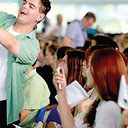[Clinical features of respiratory failure and heart failure in patients with sleep disordered breathing].
Palavras-chave
Resumo
OBJECTIVE
To assess the clinical characteristics of heart failure and respiratory failure in patients with sleep disordered breathing (SDB).
METHODS
Symptoms, signs, laboratory tests, clinical courses, blood gases responses to voluntary hyperventilation test and non-invasive ventilation treatment were analyzed in 29 patients with SDB. All patients were diagnosed as right and left heart failure and respiratory failure from 1994 to 2009 in Peking University People's Hospital.
RESULTS
Among the 29 patients recruited, 13 were male and 16 female. The mean age was 62 ± 13 yrs, and BMI was (34 ± 4) kg/m(2). Fourteen (48.3%) were diagnosed as obstructive sleep apnea syndrome at first visit. Chief complains includes dyspnea, edema, cough, snoring, hypersomnolence, oliguria, and altered mental status. Common signs include obesity, narrow upper airway, cyanosis, moist rales at the base of lungs, enlarged border of cardiac dullness, edema. Polycythemia was seen in 13 patients (44.80%), among the 26 patients who had underwent pulmonary function tests, 14 had FEV(1)/FVC ≥ 70%, the others were FEV(1)/FVC < 70%, with 6 patients had 50% predict value ≤ FEV(1) < 80% predict value and 6 patients had 30% predict value ≤ FEV(1) < 50% predict value. After positive airway pressure (BiPAP and CPAP) treatment, symptoms and arterial blood gases test results improved. Chest X-ray, CT scan and UCG show pulmonary vascular congestion and edema with cardiomegaly and possible pleural effusion, pulmonary hypertension, left ventricular diastolic dysfunction. Five patients underwent 24 h blood pressure monitoring showed non-dipping pattern or morning risen pattern of BP. In 11 patients who undertaken the test, voluntary hyperventilation induced significant improvement of SpO(2), PaCO(2) and PaO(2), and most of the parameters returned from type II respiratory failure to normal level.
CONCLUSIONS
The morbidity of SDB remained to be recognized. This cases report indicated that obese patients complaining of severe dyspnea and edema may have respiratory failure and bilateral heart failure secondary to SDB. The respiratory failure can be completely reversed by voluntary hyperventilation, and noninvasive treatments only could achieve good outcomes in most of the patients.



